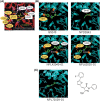Isolation and characterization of β-transducin repeat-containing protein ligands screened using a high-throughput screening system
- PMID: 37547765
- PMCID: PMC10398414
- DOI: 10.32604/or.2023.030240
Isolation and characterization of β-transducin repeat-containing protein ligands screened using a high-throughput screening system
Abstract
β-transducin repeat-containing protein (β-TrCP) is an F-box protein subunit of the E3 Skp1-Cullin-F box (SCF) type ubiquitin-ligase complex, and provides the substrate specificity for the ligase. To find potent ligands of β-TrCP useful for the proteolysis targeting chimera (PROTAC) system using β-TrCP in the future, we developed a high-throughput screening system for small molecule β-TrCP ligands. We screened the chemical library utilizing the system and obtained several hit compounds. The effects of the hit compounds on in vitro ubiquitination activity of SCFβ-TrCP1 and on downstream signaling pathways were examined. Hit compounds NPD5943, NPL62020-01, and NPL42040-01 inhibited the TNFα-induced degradation of IκBα and its phosphorylated form. Hence, they inhibited the activation of the transcription activity of NF-κB, indicating the effective inhibition of β-TrCP by the hit compounds in cells. Next, we performed an in silico analysis of the hit compounds to determine the important moieties of the hit compounds. Carboxyl groups of NPL62020-01 and NPL42040-01 and hydroxyl groups of NPD5943 created hydrogen bonds with β-TrCP similar to those created by intrinsic target phosphopeptides of β-TrCP. Our findings enhance our knowledge of useful small molecule ligands of β-TrCP and the importance of residues that can be ligands of β-TrCP.
Keywords: Chemical biology; F-box protein; Ubiquitin.
© 2023 Liu et al.
Conflict of interest statement
The authors declare that they have no conflicts of interest to report regarding the present study.
Figures





References
-
- Mukhopadhyay, D., Riezman, H. (2007). Proteasome-independent functions of ubiquitin in endocytosis and signaling. Science , 315, 201–205; - PubMed
MeSH terms
Substances
LinkOut - more resources
Full Text Sources
